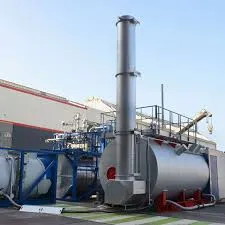
Sep . 07, 2024 00:01 Back to list
How Does a Boiler Work for Hot Water?
How Does a Boiler Work for Hot Water?
Boilers are essential components of heating systems that provide hot water for residential and commercial use. They operate on a relatively straightforward principle, utilizing various energy sources to heat water, which is then delivered to taps, radiators, or underfloor heating systems. Understanding how a boiler works can help homeowners and building managers maintain their systems efficiently and recognize potential issues.
At its core, a boiler heats water through a process called combustion, where fuel (natural gas, oil, or even electricity) is burned to create heat. In gas-fired boilers, for instance, gas is mixed with air and ignited within a combustion chamber, producing hot gases that transfer their heat to water in a heat exchanger. This heat exchanger is a series of coils or tubes where the water circulates, absorbing the heat from the combustion gases.
Hot Water Production Process
The process begins with the boiler filling up with cold water, usually from the main supply or a storage tank. Once the demand for hot water is registered—whether it's a faucet being turned on or a thermostat reaching a setpoint—the boiler's burner ignites, and the water is heated to the desired temperature. In modern systems, a temperature sensor helps ensure that the water remains at a consistent temperature by regulating the burner's operation.
Most boilers can be classified into two types conventional and combi boilers. Conventional boilers typically store hot water in a tank, sometimes referred to as a hot water cylinder, ready for use. This model ensures that there's always hot water available but can lead to higher energy consumption due to heat loss from the stored water.
On the other hand, combi boilers, or combination boilers, heat water on demand. This means they do not require a separate storage tank, providing hot water directly to the tap as needed. This type of boiler is particularly efficient for homes with limited space, as it eliminates the need for bulky storage tanks.
how does a boiler work for hot water

System Components
Key components of a boiler include
1. Burner Responsible for the combustion of fuel. 2. Heat Exchanger Transfers heat from the combustion gases to the water. 3. Controls Thermostats and sensors regulate the temperature and ensure safe operation. 4. Pump Circulates the heated water throughout the system.
Boiler systems can also incorporate additional features, such as expansion tanks and safety valves, which prevent pressure build-up and protect the system from malfunctions.
Maintenance and Considerations
Regular maintenance is crucial for keeping a boiler operating efficiently. This includes annual inspections, cleaning, and testing safety controls. Homeowners should also be aware of potential issues like leaks, unusual noises, or fluctuating water temperatures, as these can indicate underlying problems.
In conclusion, understanding how a boiler works is fundamental for anyone relying on this system for hot water. Whether in a cozy home or a bustling commercial environment, knowledge of the components and functions of a boiler enhances both efficiency and safety, ensuring a reliable supply of hot water when it's needed most.
-
High-Efficiency Commercial Oil Fired Steam Boiler for Industry
NewsJul.30,2025
-
High-Efficiency Biomass Fired Thermal Oil Boiler Solutions
NewsJul.30,2025
-
High Efficiency Gas Fired Thermal Oil Boiler for Industrial Heating
NewsJul.29,2025
-
High-Efficiency Gas Fired Hot Water Boiler for Sale – Reliable & Affordable
NewsJul.29,2025
-
High Efficiency Biomass Fired Hot Water Boiler for Industrial and Commercial Use
NewsJul.29,2025
-
High-Efficiency Biomass Fired Hot Water Boiler for Industrial Use
NewsJul.28,2025
Related PRODUCTS






















